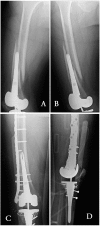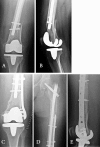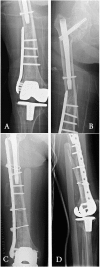Periprosthetic knee fractures. A review of epidemiology, risk factors, diagnosis, management and outcome
- PMID: 28657573
- PMCID: PMC6179004
- DOI: 10.23750/abm.v88i2-S.6522
Periprosthetic knee fractures. A review of epidemiology, risk factors, diagnosis, management and outcome
Abstract
Background and aim of the work: Periprosthetic knee fractures incidence is gradually raising due to aging of population and increasing of total knee arthroplasties. Management of this complication represents a challenge for the orthopaedic surgeon. Aim of the present study is to critically review the recent literature about epidemiology, risk factors, diagnosis, management and outcome of periprosthetic knee fractures.
Methods: A systematic search of Embase, Medline and Pubmed was performed by two reviewers who selected the eligible papers favoring studies published in the last ten years. Epidemiology, risk factors, diagnostic features, clinical management and outcome of different techniques were all reviewed.
Results: 52 studies including reviews, meta-analysis, clinical and biomechanical studies were selected.
Conclusions: Correct clinical management requires adequate diagnosis and evaluation of risk factors. Conservative treatment is rarely indicated. Locking plate fixation, intramedullary nailing and revision arthroplasty are all valuable treatment methods. Surgical technique should be chosen considering age and functional demand, comorbidities, fracture morphology and location, bone quality and stability of the implant. Given the correct indication all surgical treatment can lead to satisfactory clinical and radiographic results despite a relevant complication rate.
Keywords: periprosthetic knee fractures, TKA, complications, management, supracondylar, patella, tibia.
Figures





Similar articles
-
Post-operative periprosthetic humeral fractures after reverse shoulder arthroplasty: a review of the literature.Acta Biomed. 2019 Dec 5;90(12-S):8-13. doi: 10.23750/abm.v90i12-S.8974. Acta Biomed. 2019. PMID: 31821278 Free PMC article. Review.
-
Similar outcomes of locking compression plating and retrograde intramedullary nailing for periprosthetic supracondylar femoral fractures following total knee arthroplasty: a meta-analysis.Knee Surg Sports Traumatol Arthrosc. 2017 Sep;25(9):2921-2928. doi: 10.1007/s00167-016-4050-0. Epub 2016 Feb 20. Knee Surg Sports Traumatol Arthrosc. 2017. PMID: 26897137 Review.
-
[Osteosynthesis for periprosthetic supracondylar fracture above a total knee arthroplasty using a locking compression plate].Acta Chir Orthop Traumatol Cech. 2009 Dec;76(6):473-8. Acta Chir Orthop Traumatol Cech. 2009. PMID: 20067694 Czech.
-
Periprosthetic fractures about total knee arthroplasty.Musculoskelet Surg. 2020 Aug;104(2):135-143. doi: 10.1007/s12306-019-00628-9. Epub 2019 Oct 23. Musculoskelet Surg. 2020. PMID: 31643045 Review.
-
Periprosthetic tibial fractures in total knee arthroplasty - an outcome analysis of a challenging and underreported surgical issue.BMC Musculoskelet Disord. 2018 Sep 11;19(1):323. doi: 10.1186/s12891-018-2250-0. BMC Musculoskelet Disord. 2018. PMID: 30200931 Free PMC article.
Cited by
-
Clinical outcomes, complications, and survivorship for unicompartmental knee arthroplasty versus total knee arthroplasty in patients aged 80 years and older with isolated medial knee osteoarthritis: a matched cohort analysis.Arch Orthop Trauma Surg. 2023 Oct;143(10):6371-6379. doi: 10.1007/s00402-023-04916-9. Epub 2023 May 27. Arch Orthop Trauma Surg. 2023. PMID: 37244888 Free PMC article.
-
Whole Span Plating Prevents Subsequent Ipsilateral Femoral Fractures After Peri-Implant Fixation: A Preliminary Report.J Clin Med. 2025 May 15;14(10):3473. doi: 10.3390/jcm14103473. J Clin Med. 2025. PMID: 40429467 Free PMC article.
-
Management, outcome, and novel classification system of periprosthetic fractures in patients with transcutaneous osseointegrated prosthetic systems (TOPS)-a retrospective cohort analysis.Arch Orthop Trauma Surg. 2022 Jul;142(7):1499-1509. doi: 10.1007/s00402-021-03826-y. Epub 2021 Mar 6. Arch Orthop Trauma Surg. 2022. PMID: 33675390 Free PMC article.
-
Effectiveness of ultrasonographic skeletal muscle assessment in patients after total knee arthroplasty.Osteoporos Sarcopenia. 2019 Sep;5(3):94-101. doi: 10.1016/j.afos.2019.09.002. Epub 2019 Sep 25. Osteoporos Sarcopenia. 2019. PMID: 31728427 Free PMC article.
-
Failure of Less-Invasive Stabilization System (LISS) plating for periprosthetic distal femur fractures: Three case reports.Medicine (Baltimore). 2020 Feb;99(8):e19195. doi: 10.1097/MD.0000000000019195. Medicine (Baltimore). 2020. PMID: 32080105 Free PMC article.
References
-
- Dennis DA. Periprosthetic fractures following total knee arthroplasty. Instr Course Lect. 2001;50:379–89. - PubMed
-
- Kurtz S, Ong K, Lau E, Mowat F, Halpern M. Projections of primary and revision hip and knee arthroplasty in the United States from 2005 to 2030. J Bone Joint Surg Am. 2007 Apr;89(4):780–5. - PubMed
-
- Italian Arthroplasty Registry Project. Approaching data quality. Third Report. 2016
-
- Kim KI, Egol KA, Hozack WJ, Parvizi J. Periprosthetic fractures after total knee arthroplasties. Clin Orthop Relat Res. 2006 May;446:167–75. - PubMed
Publication types
MeSH terms
LinkOut - more resources
Full Text Sources
Medical
Research Materials
